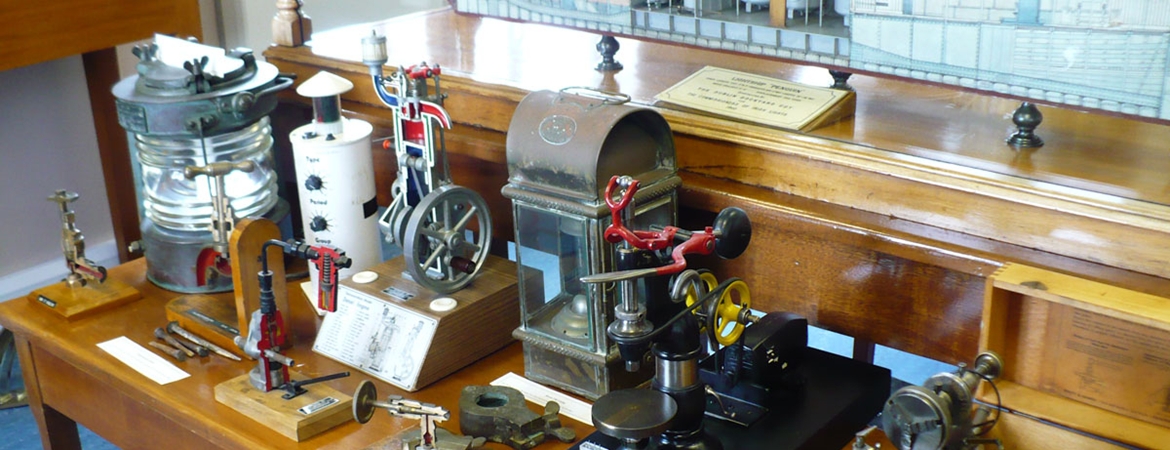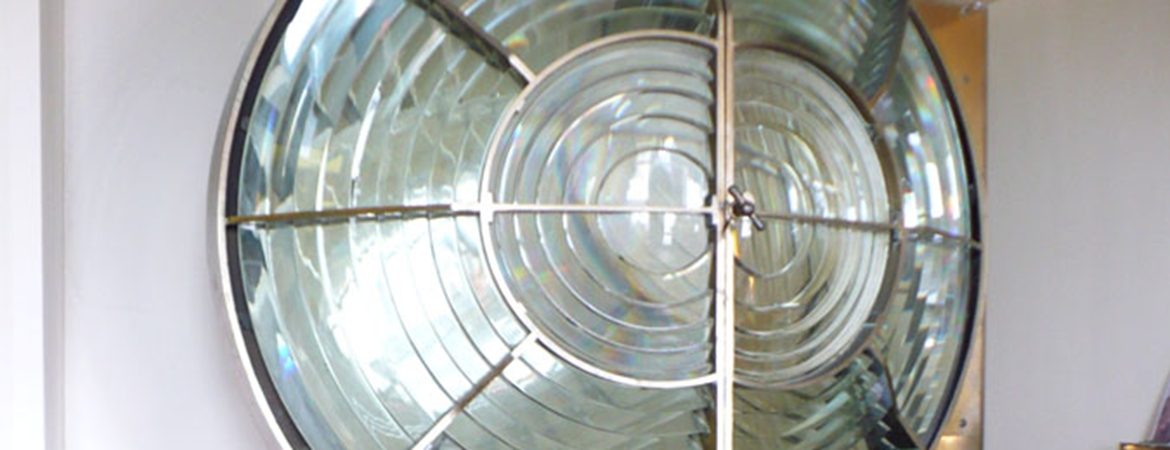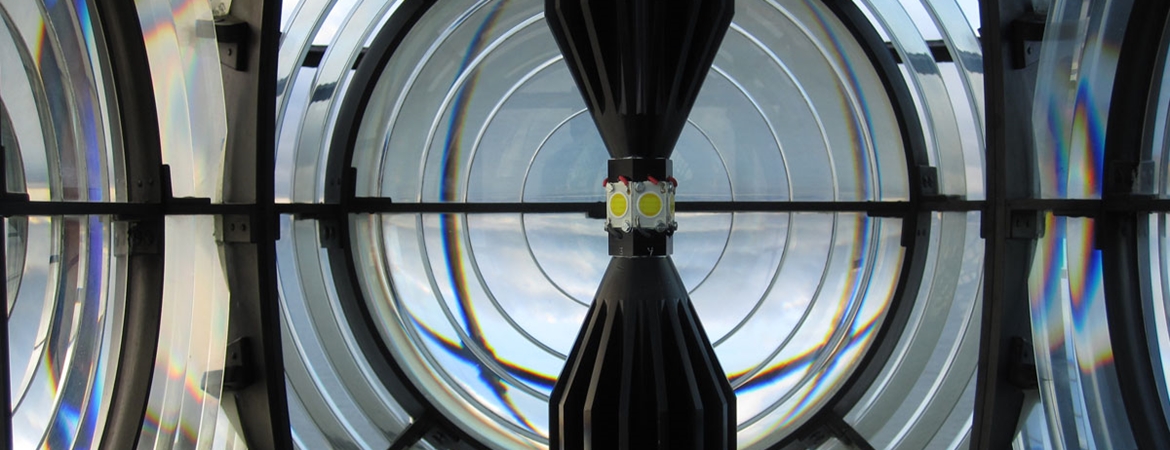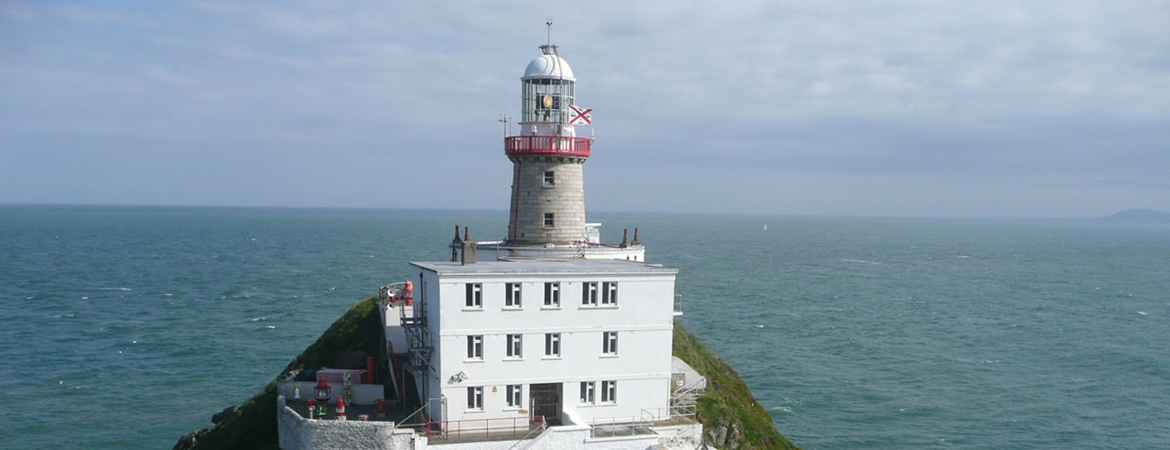In 1665 Charles II granted Sir Robert Reading letters patent to build six lighthouses around the coast of Ireland. A cottage-type lighthouse (a type of lighthouse unique in Ireland) was established on Howth Head about 1667. It consisted of a small cottage with battered walls, which is still in situ, with a coal-burning beacon on top of a square tower positioned against the eastern gable end of the cottage. Coal and other requisites were brought to the lighthouse by horses, carts, and carriages from the quay specially built for the lighthouse at the village of Howth.
In 1790 Thomas Rogers, Lighthouse Contractor and Inspector to the Revenue Commissioners, replaced the coal burning light with a tower surmounted by a lantern. The light source was six Argand oil lamps, each with a silvered copper parabolic reflector directing the light through six bulls eye panes set in the lantern, which acted as crude lenses.
The light, like a number of its contemporaries, was quite often obscured by mist or cloud due to its position high on the hill, so the Corporation for Preserving and Improving the Port of Dublin, who had taken over the fourteen coastal lighthouses from the Revenue Commissioners in 1810, recommended on 5th December 1811 that the light be repositioned lower down on the headland at the Little Baily, or Duncriffan.
BAILY LIGHTHOUSE
The new tower and Keepers' dwelling were designed by George Halpin Senior, the Board's Inspector of Works, who also supervised the construction which was carried out by the Board's tradesmen. The fixed white catoptric light comprising twenty four Argand oil lamps and reflectors was established, 134 feet (41m) above high water, on 17th March 1814. The cut granite tower was painted white and remained so until 1910 when, on the recommendation of the Engineer to the Commissioners of Irish Lights, it was changed to its natural granite colour.
Over the years a number of vessels have run up against the rocks or cliffs around Howth Head. One such occurrence was on the 3rd August 1846, when the City of Dublin Steam Packet Company's paddle steamer Prince struck the cliffs in thick fog near the nose of Howth 2.5 km north of the Baily. The Board could not be sure if fog bells would have prevented the accident, but agreed it would be advisable to erect bells sounded by machinery at the station.
With regard to the fog bell that should have been erected in 1846, George Halpin reported that the erection of the bell at the Baily had been postponed due to the urgency of other works being undertaken around the coast. Two months after the tragedy of the Queen Victoria on 15th February 1853, the Corporation informed the Board of Trade that the fog bell was in the course of erection. Although no record survives, the bell would have been in operation by the end of April 1853.
A Committee was set up in April 1863 to look into better marking of the south-east coast between Kish and Tuskar. One of its recommendations was to convert the light at the Baily from catoptric to First Order dioptric. Messrs. Edmundson & Co. of Dublin supplied the first order lantern, Messrs. Wilkins of London the first order dioptric apparatus, and Mr Toomey of Dublin supplied the cast iron lantern floor, all of which were installed during the summer of 1865.
Around this time, Mr John R. Wigham of Messrs Edmundson and Company had patented his inventions for illuminating lighthouses with gas. Later in 1865 the Board directed Mr Wigham to commence experiments at the Baily. The gas was at first made from oil, then shale, and finally rich cannel coal, in a gas works at the station. In the wake of its success, nine other lighthouses were converted to either oil gas or coal gas.
The Commissioners of Irish Lights became interested in an air trumpet foghorn which had been developed by an American, Mr C. L. Daboll. It was on show at an exhibition in Paris in May 1867 and was basically a small coal fired hot air engine, which compressed air in a cylinder on top of which was a reed horn. When the exhibition closed in November 1867, the fog signal was transported to Dublin, but was not established at the Baily until 1871. The horn was replaced by a siren in 1879, and the siren by a G type diaphone in 1926. It is interesting to note that the bell was not removed until 1890. Obviously it was used as a standby for Daboll's horn and in the first few years of the siren.
During 1897 Mr W. Douglass, the Commissioners' Engineer, recommended that the Baily light should be improved and converted to flashing. The new light, with a character of one flash every thirty seconds, came into operation on 1st January 1902. After over forty years of operation by gas light, the light source at Baily Lighthouse was converted to incandescent vaporised paraffin when a Chance Brothers triple 50mm burner was commissioned on 25th October 1908.
Baily's optic was to receive yet another change in June 1972. A completely new AGA 375mm lens driven by an AGA PRB20 gearless pedestal was installed. The light source was a 1500W 100V L24 electric lamp. The light was permanently exhibited at Fl W every 20 seconds with a range of 26 nautical miles. The 1902 optic, pedestal, and rotation machine are preserved in the Maritime Institute of Ireland's Museum at Dun Laoghaire.
Two semi-detached dwellings for Assistant Keepers were built on the hill to the north of the lighthouse in 1892, and a detached two story house was built in 1953 for the Principal Keeper in the yard below the Lighthouse. New quarters for Supernumerary Assistant Keepers were constructed in 1973 below the lighthouse on the opposite side of the yard to the Principal Keeper's dwelling. Baily Lighthouse was used as a training lighthouse to train Supernumerary Assistant Lighthouse Keepers before they were transferred to lighthouses around the coast. The Assistant Keepers' houses were sold in September 1995.
From 1978 the light at Baily was exhibited in poor visibility when the fog signal was sounding.
Like all rock and mainland stations, Baily became relieving in 1982. Since 1983 it has been the landward base for helicopter operations to Kish Bank and Rockabill lighthouses.
On 30th January 1992 the radiobeacon at Kish Lighthouse was discontinued and replaced by a new radiobeacon and radio direction-finder calibration service at Baily. In more recent times utilisation of radio direction finders by mariners has been to a great extent superceded by more modern technology. For this reason the Commissioners discontinued their Medium Frequency Radiobeacon service on 1st February 1999.
After a trial period of three months the fog signal was permanently discontinued from 11th January 1995.
During 1996-7 the lighthouse was converted to automatic operation. The Lighthouse Keepers were withdrawn from Baily on 24th March 1997 and left the Service on early retirement. Baily was the last Irish Lighthouse to be unwatched. The character of the light was changed to Fl W 15 s on the 27th February 1996 in anticipation of the automation of the station. The Aids to Navigation are controlled and monitored via a telemetry link from irish Lights Dun Laoghaire. The station is in the care of an Attendant who lives at the station in the former Principal Keeper's house. The light is currently a 375mm catadioptric annular lens with electric L24 lamps in a UVLA lampchanger.
As part of an extensive upgrade of Vessel Traffic Services in Dublin Port which was put into operation in July 1999, the Commissioners of Irish Lights provided facilities for Dublin Port Company to install radar and communication equipment at Baily Lighthouse.
Baily Lighthouse
|
Position: |
53°21.691' North 06°03.158' West |
Aids to Navigation |
|
|
Sectors: |
|
|
Height of Tower: |
13 metres |
|
Height of Light MHWS: |
41 metres |
|
Character: |
Fl W 15s. Exhibited by day in poor visibility |
|
Range: |
18 nautical miles |
|
Radar Beacon: |
|
|
AIS: |
AIS Base station |
Tags :
lighthouse
,
Baily
















